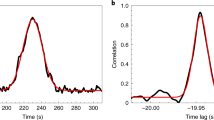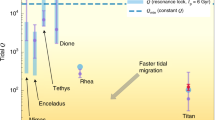Abstract
VENUS rotates with a period of 243.00 ± 0.04 d retrograde1. The obliquity, or angle between the spin vector and orbit vector is 178 ± 1° (ref. 1). Both the long period and the near 180° obliquity suggest that the spin has evolved under the influence of tidal torques. Tides raised by the Sun in the body of Venus would de-spin the planet in ∼108 yr if no other torques were acting2. The final state would be one of synchronous rotation (one side always facing the Sun). So either we are living during the final stages of Venus' tidal evolution, an unlikely circumstance, or else Venus has already reached a stable equilibrium in which other influences balance the solar body tide. It is possible that the Earth has ‘captured’ Venus into a resonance in which the spin period is 243.165 d. However, for this resonance to be a stable equilibrium, either Venus must have a gravitational field that is ∼10 times ‘rougher’ than the Earth's2, a possibility that is largely ruled out by direct observation3, or a third torque must balance the body torque due to the Sun. Tides in the atmosphere driven by periodic solar heating could supply the necessary third torque4–6, but no quantitative theory has previously been published. Such a theory7 is presented here, in which we argue that the current rotation is a stable balance between atmospheric and solar body tides.
Similar content being viewed by others
References
Shapiro, I., Campbell, D. & DeCampli, W. Astrophys. J. Lett. (submitted).
Goldreich, P. & Peale, S. Astr. J. 72, 662–668 (1967); 75, 273–284 (1970).
Howard, H. T. et al. Science 183, 1297–1300 (1974).
Gold, T. & Soter, S. Icarus 11, 356–366 (1969).
Hinch, E. J. Lecture notes from the Woods Hole Oceanographic Institution Summer Study Program in Geophysical Fluid Dynamics (1970).
Kundt, W. Astr. Astrophys. 60, 85–91 (1977).
Ingersoll, A. & Dobrovolskis, A. Bull. Am. astr. Ass. 9, 467 (1977).
Keldysh, M. V. Icarus 30, 605–625 (1977).
Munk, W. & MacDonald, G. The Rotation of the Earth (Cambridge University Press, 1975).
Author information
Authors and Affiliations
Rights and permissions
About this article
Cite this article
INGERSOLL, A., DOBROVOLSKIS, A. Venus' rotation and atmospheric tides. Nature 275, 37–38 (1978). https://doi.org/10.1038/275037a0
Received:
Accepted:
Issue Date:
DOI: https://doi.org/10.1038/275037a0
- Springer Nature Limited
This article is cited by
-
Magma Ocean, Water, and the Early Atmosphere of Venus
Space Science Reviews (2023)
-
Synergies Between Venus & Exoplanetary Observations
Space Science Reviews (2023)
-
Atmospheric dynamics of a near tidally locked Earth-sized planet
Nature Astronomy (2022)
-
Spin state and moment of inertia of Venus
Nature Astronomy (2021)
-
A Review of Possible Planetary Atmospheres in the TRAPPIST-1 System
Space Science Reviews (2020)





